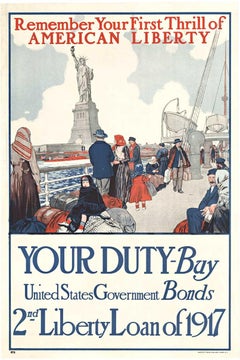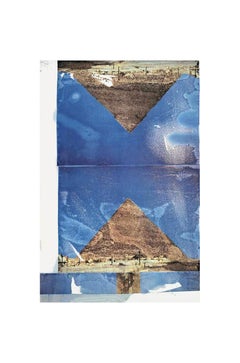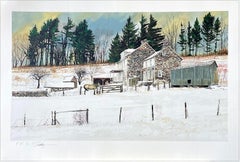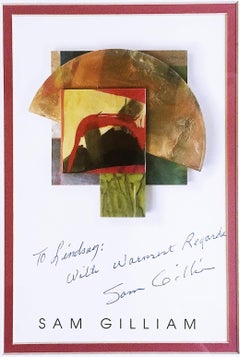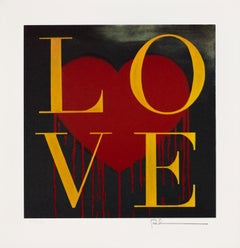Art by Medium: Lithograph
to
8,312
16,315
6,271
8,948
3,416
1,694
Overall Width
to
Overall Height
to
68
5,578
28,609
2,414
356
443
1,013
1,160
1,588
3,737
5,043
6,549
3,204
1,175
46
10,633
4,011
3,460
2,500
1,499
887
802
579
458
130
94
90
57
54
24,831
11,127
588
16,531
9,004
6,098
5,543
5,007
3,951
3,746
2,426
2,348
2,202
1,967
1,451
1,367
1,309
1,175
1,021
926
900
820
750
36,672
182,687
96,629
78,198
77,327
798
756
537
366
271
3,640
11,435
20,102
12,799
Medium: Lithograph
Original Remember Your First Thrill of American Liberty 1917 vintage poster
Located in Spokane, WA
Original poster: Rembember Your First Thrill of Ameridan Liberty YOUR DUTY Buy United States Government Bonds 2nd Liberty Loan of 1917. Linen backed and ready to frame. Poste...
Category
1910s American Realist Art by Medium: Lithograph
Materials
Lithograph
Architecture
Located in Calabasas, CA
Artist: Robert Rauschenberg
Title: Architecture
Year: 1994
Medium: Lithograph with vegetable dye water transfer on Arches Infinity paper
Edition: 50; signed, dated and numbered in pe...
Category
1990s Contemporary Art by Medium: Lithograph
Materials
Lithograph
LITTLEWOODS Signed Lithograph, Historic Stone Farmhouse, Bucks County Landscape
Located in Union City, NJ
LITTLEWOODS is an original hand drawn, limited edition lithograph by Peter Sculthorpe (b.1948 Ontario, Canada) printed using hand lithography techniques on archival Arches paper, 100...
Category
1980s Realist Art by Medium: Lithograph
Materials
Lithograph
Lovers with Bouquet of Flowers - Original lithograph - 1965
By Marc Chagall
Located in Paris, IDF
Marc CHAGALL
Colorful Bouquet of Flowers
Stone lithograph in colors (Mourlot workshop)
Engraved by Sorlier under the supervision of Marc Chagall
Printed signature in the plate
On Arches vellum 38 x 28 cm (c. 15 x 11 in)
INFORMATION :
Edited for the portfolio Les Peintres mes amis (Les Heures Claires...
Category
1960s Modern Art by Medium: Lithograph
Materials
Lithograph
Offset Lithograph signed & warmly Inscribed to African American Arts prof Framed
By Sam Gilliam
Located in New York, NY
Sam Gilliam
Offset Lithograph Warmly Inscribed to Renowned African American Arts Educator, 1988
Offset Lithograph Card
Hand written, signed and inscribed card with a warm personal message from the artist
Frame Included
Hand written, signed and inscribed offset lithograph card with a warm personal message from Sam Gilliam to Lindsay Waldorf Patterson.
Measurements:
Frame:
14 7/8 x 12 x 1/2 inches
Card:
8 x 5 inches
The inscription reads:
To Lindsay:
With Warmest Regards
Sam Gilliam
Lindsay Waldorf Patterson was an American English literature educator and author as well as a MacDowell Colony fellow (3 awards); Edward Albee Foundation fellow (2 awards); recipient award National Foundation on Arts & Humanities.
Hand signed on the front
Provenance:
From the estate of Lindsay Waldorf Patterson. Lindsay Waldorf Patterson was an American English literature educator and author as well as an MacDowell Colony fellow (3 awards); Edward Albee Foundation fellow (2 awards); recipient award National Foundation on Arts & Humanities.
Formerly an account executive, Harrison Advertising Agency, New York City, 1964; feature writer and columnist assistant to Langston Hughes, Associated Negro Press, 1965; special feature writer (film) Uptight,, Paramount Pictures, 1968; co-host Celebrity Hour program, Station WRVR-FM, New York City, 1974-1977; co-host Black Conversations program, Station WPIX-television, New York City, 1976-1979; assistant Professor of English, Queens College, Flushing, New York, since 1990. Adjunct Professor Afro-American & Caribbean literature, black theater...
Category
1980s Abstract Expressionist Art by Medium: Lithograph
Materials
Lithograph, Offset, Ink
Love
Located in Greenwich, CT
Love is a lithograph on paper, 9 x 9" image size. From the edition of 395, numbered 219/275 (there were also 100 Roman and 20 AP), framed in a contemporary, silver-tone frame - visua...
Category
21st Century and Contemporary Contemporary Art by Medium: Lithograph
Materials
Paper, Lithograph
TWO FLOATING Signed Lithograph, Abstract Balloons, Pop Art, Red Pink Yellow Blue
By Peter Max
Located in Union City, NJ
TWO FLOATING is an original hand drawn lithograph by the renowned American Pop artist, Peter Max, printed in 1991 in an edition of 165, using traditional hand lithography techniques on archival Somerset paper, 100% acid free. TWO FLOATING is a dreamy, New Age style, upbeat abstract composition portraying a colorful, dandy man dressed in a blue striped jacket with yellow sleeves exiting from the left as a group of floating red, yellow, and light blue balloon shapes suspended in the air against a background of warm rosy pink; a white and yellow sphere resting on the ground. TWO FLOATING is an airy, transcendental, happy colored fantasy moment!
Print size - 28 x 22 inches. unframed, very good condition, hand signed by Peter Max
Image size - 23.5 x 19 inches
Edition size - 165
Year published - 1980
Printer - JK Fine Art Editions Co. NY
About the artist -
German/American artist: b. 1937, Peter Max spent his childhood in Shanghai. From China, the family went to Tibet for a year, and then on to Israel. Peter Max's family's odyssey continued to Paris, and finally, at the age of 16, Max arrived in the United States. Peter Max began his art studies in New York at the Art Student's League and continued at the Pratt Institute and School of Visual Arts. Peter Max, recognised throughout the world and a well-known name in America, is famous for his new age style, cosmic imagery and multi-colored blends. During the late 1960's and early 70's, Peter Max's colorful award winning art reached millions of people. Peter Max's paintings, drawings, sculpture and limited edition graphics have been exhibited in major museums throughout the world.
American icons, especially the Statue of Liberty, appear repeatedly in his art repertoire. Returning to the public art scene in the ‘80s...
Category
1980s Pop Art Art by Medium: Lithograph
Materials
Lithograph
$1,056 Sale Price
42% Off
Ritual Mark Tobey abstract black tan and white lithograph
By Mark Tobey
Located in New York, NY
This delicate composition in black and tan features layers of sheer brushwork, inky daubs, and thin lines. Mark Tobey, one of the founders of the American Mystical school of painting...
Category
1970s Abstract Art by Medium: Lithograph
Materials
Lithograph
Original Fake 2006 (KAWS Japan announcement)
By KAWS
Located in NEW YORK, NY
KAWS Original Fake 2006:
A rare, much historic invitation published on the occasion of a KAWS Medicom Toy reception at KAWS' Original Fake Tokyo sho...
Category
21st Century and Contemporary Pop Art Art by Medium: Lithograph
Materials
Offset, Paper, Lithograph
$340 Sale Price
31% Off
Village de Provence
Located in San Francisco, CA
This artwork "Village de Provence" c.1970 Is an original colors lithograph by noted French artist Denis Paul Noyer, b.1940. It is signed and number...
Category
Late 20th Century Modern Art by Medium: Lithograph
Materials
Lithograph
Original "Bombay" (American President Line) small format vintage travel poster
Located in Spokane, WA
Original poster: BOMBAY (American President Lines) Small format without text along the bottom. This is the smaller format for the poster. Archival linen-backed in very fine cond...
Category
1950s American Modern Art by Medium: Lithograph
Materials
Lithograph
The Gates Project for Central Park, New York (18370)
Located in New York, NY
Serigraph
Signed in pencil
Category
21st Century and Contemporary Contemporary Art by Medium: Lithograph
Materials
Lithograph, Screen
Joan Miró ( 1893 – 1983 ) - hand-signed Lithograph on Guarro paper – 1974
By Joan Miró
Located in Varese, IT
color lithograph on Guarro paper , edited in 1974
Limited Edition of 75 copies plus 15 HC
Hand signed, dated and numbered in pencil 37/75 in pencil (lower left)
Paper size: 69,5 x 52...
Category
1970s Surrealist Art by Medium: Lithograph
Materials
Lithograph
Ubac, Composition, Derrière le miroir (after)
By Raoul Ubac
Located in Auburn Hills, MI
Lithograph on vélin paper. Inscription: Unsigned and unnumbered, as issued. Good condition. Notes: From Derrière le miroir, N° 105-106, 1958. Published by Aimé Maeght, Éditeur, Paris...
Category
1950s Modern Art by Medium: Lithograph
Materials
Lithograph
$716 Sale Price
20% Off
Chantal sur le Banc Blanc - Galerie Des Chaudronniers by André Brasilier, 1981
Located in New York, NY
Artist: André Brasilier
Medium: Original Lithographic Poster, 1981
Dimensions: 29.92 x 20.67 in, 76 x 52,5 cm
Classic Poster Paper - Great Condition A
This original lithographic ...
Category
1980s Art by Medium: Lithograph
Materials
Lithograph
'I'll Be What I Choose' — Mid-century American Surrealism
Located in Myrtle Beach, SC
'I'll Be What I Choose: Vanity of Ambition', color lithograph, 1949, edition 40, Fine and Looney 281. Signed, titled, and numbered '23/40' in pencil. Initialed in the stone, lower ri...
Category
1940s American Modern Art by Medium: Lithograph
Materials
Lithograph
$960 Sale Price
20% Off
Ruine, Surrealist Lithograph by André Masson
By André Masson
Located in Long Island City, NY
André Masson, French (1896 -1987) - Ruine, Year: 1945, Medium: Lithograph, signed and numbered in pencil, Edition: 10/30, Image Size: 8 x 6.25 inches, Size: 14 x 11 in. (35.56 x...
Category
1940s Surrealist Art by Medium: Lithograph
Materials
Lithograph
original lithograph
Located in Henderson, NV
Medium: original lithograph. Printed in Paris in 1967 at the atelier of Clot, Bramsen et Georges and published in an edition of 2500 for "Les Temps Situationistes" (The Situationist ...
Category
1960s Art by Medium: Lithograph
Materials
Lithograph
circa 1960 “Hawaii” poster by Continental Airlines
Located in PARIS, FR
The circa 1960 “Hawaii” poster by Continental Airlines is an iconic example of mid-20th-century travel advertising, blending bold graphics with the spiri...
Category
1960s Art by Medium: Lithograph
Materials
Paper, Lithograph
Japan, Suijin Shrine and Masaki on the Sumida River - Lithograph (Mourlot)
Located in Paris, IDF
Utagawa HIROSHIGE (1797-1858, after)
Japan, Suijin Shrine and Masaki on the Sumida River
Lithograph after a woodcut (Mourlot workshop)
Printed signature in the plate
Numbered / 150 ...
Category
Mid-20th Century Edo Art by Medium: Lithograph
Materials
Lithograph
Musee National d'Art Moderne (after) Wassily Kandinsky - Abstract
Located in New York, NY
This rare lithographic poster was printed in 1957 at the Atelier Mourlot in Paris. It was created to promote an exhibition of artworks by Kandinsky, on loan from the Guggenheim Museum to the National Museum of Modern in Paris.
Certificate of Provenance:
Each individual work of art carefully curated by Mourlot Editions comes with a Certificate of Provenance, signed, dated, stamped, and numbered by Eric Mourlot. This certificate guarantees the origin and authenticity of your personal lithograph.
About the Artist:
Kandinsky was a painter and art theorist, one of the first creators of pure abstraction in modern painting. After successful avant-garde exhibitions, he founded the influential Munich group Der Blaue...
Category
1950s Abstract Geometric Art by Medium: Lithograph
Materials
Lithograph
"Femmes et Oiseaux devant la Lune" original pochoir
By Joan Miró
Located in Henderson, NV
Medium: original pochoir stencil print in five colors. Catalogue reference: Dupin 50. Printed in 1947 in an edition of 1500 by Meriden Gravure and published by Curt Valentin for the ...
Category
1940s Surrealist Art by Medium: Lithograph
Materials
Lithograph, Stencil
Composition, Derrière le miroir
Located in Auburn Hills, MI
Lithograph on vélin paper. Paper Size: 15 x 11 inches. Inscription: Unsigned and unnumbered, as issued. Notes: From the folio, Derrière le miroir, N° 43, 1952. Published by Aimé Maeg...
Category
1950s Modern Art by Medium: Lithograph
Materials
Lithograph
$716 Sale Price
20% Off
Circa 1900 Art Nouveau advertising poster for Fumar el papel JOB
Located in PARIS, FR
This circa 1900 Art Nouveau advertising poster, designed by Peruvian-born artist Daniel Hernández, is a stunning example of early 20th-century luxury brand marketing. Created for JOB cigarette rolling papers, the advertisement reflects the era’s elegant aesthetics and sophisticated lifestyle appeal. The slogan, "Fumar el papel JOB o dejar de fumar" ("Smoke JOB paper or stop smoking"), emphasizes the brand’s prestige and superior quality, making it seem indispensable for tobacco connoisseurs.
The artwork features a sensual and dreamlike composition, characteristic of the Belle Époque. A radiant red-haired woman, partially draped in sheer fabric, lounges in a relaxed pose, smiling seductively as she delicately holds a lit cigarette. The soft pastels, golden hues, and fluid lines create a warm, ethereal atmosphere, reinforcing the romantic and luxurious associations of the JOB brand. The swirling wisps of smoke, artistically integrated into the design, echo the organic, flowing forms typical of Art Nouveau illustration. The ornate green decorative border further enhances the visual richness, framing the central figure like a jewel in an exquisite setting.
At the turn of the century, tobacco advertising was at its peak, and brands relied on opulent, aspirational imagery to captivate consumers. JOB, a French rolling paper company founded in the 1830s, became known for collaborating with renowned artists to create highly collectible posters. This particular piece, executed with remarkable softness and luminosity, reflects Hernández’s mastery of portraiture and classical technique, which he refined during his studies in Europe. His ability to capture the sensuality and grace of the female form made him a sought-after artist for both fine art and commercial illustration.
Beyond its commercial function, this poster is an important example of the fusion between fine art and advertising, a defining feature of Art Nouveau poster design. It demonstrates how companies in the early 20th century elevated advertising into an art form, commissioning celebrated painters to craft exquisite promotional imagery. Today, original JOB posters...
Category
Early 1900s Art by Medium: Lithograph
Materials
Paper, Lithograph
Man Ray, Composition, Man Ray, Electa Editrice Portfolios (after)
By Man Ray
Located in Auburn Hills, MI
Héliogravure on vélin paper. Inscription: unsigned and unnumbered, as issued. Good condition. Notes: From the folio, Man Ray, Electa Editrice Portfolios, 1980. Published and printed ...
Category
1980s Surrealist Art by Medium: Lithograph
Materials
Lithograph
$956 Sale Price
20% Off
Eggs, natural history chromolithograph, circa 1900
Located in Melbourne, Victoria
'Eggs'
Antique English natural history chromolithograph. Key to eggs below the image. Tiny numbers in the margins to identify the eggs.
Sheet 19cm by 12.5cm, image 13cm by 9.5cm.
Category
Early 1900s Naturalistic Art by Medium: Lithograph
Materials
Lithograph
The Family - Lithograph by Umberto Brunelleschi - 1930s
Located in Roma, IT
The Family is a color lithograph on ivory paper, created by the Italian artist Umberto Brunelleschi (Montemurlo 1879- Paris 1949).
Illustration for “Tales and Short Stories” by La ...
Category
1930s Art Nouveau Art by Medium: Lithograph
Materials
Lithograph
$178 Sale Price
25% Off
Sinjerli Variation I Lithograph & Screenprint Hand Signed Ed 100. Created 1977
By Frank Stella
Located in Philadelphia, PA
Frank Stella b.1936
Sinjerli Variation I
1977
lithograph and screenprint in colors on Arches Cover
31¾ h × 42 w in (81 × 107 cm)
Signed, dated and numbered to lower right edition of...
Category
1970s Abstract Geometric Art by Medium: Lithograph
Materials
Lithograph, Screen
Gemini-The Twins
Located in Fairlawn, OH
Signed in the right center edge of the image
From: Les Douze Mois de 1889
As published in Vol. 9, No. 425 of Les Hommes d'Aujourd'hui.
Published by Sagot, Paris
Proof before letters...
Category
1880s Art Nouveau Art by Medium: Lithograph
Materials
Lithograph
(after) Milivoj Uzelac - "Vins, amours et fantaisies" pochoir
Located in Henderson, NV
Medium: pochoir (after the watercolor). Printed on Arches paper in 1956 at the atelier Daniel Jacomet for the Vins, fleurs et flammes portfolio, and issued in a limited edition of 38...
Category
1950s Art by Medium: Lithograph
Materials
Lithograph
Klimt, Die Umarmung, Gustav Klimt, Eine Nachlese (after)
By Gustav Klimt
Located in Auburn Hills, MI
Héliogravure, collotype, metallic inks on vélin paper. Paper Size: 18.86 x 17.91 inches; image size: 12.24 x 7.6 inches. Inscription: Signed in the plate and unnumbered, as issued. N...
Category
1930s Symbolist Art by Medium: Lithograph
Materials
Lithograph
$19,996 Sale Price
20% Off
The Cat's Paw
By John Doyle
Located in Middletown, NY
An iconic image satirizing the Prime Minister at the 1832 London Conference.
The Cat's Paw (Charles Maurice de Talleyrand-Périgord, Prince de Benevento & Henry John Temple...
Category
Early 19th Century English School Art by Medium: Lithograph
Materials
Handmade Paper, Lithograph
THE DOOR OF JUSTICE Hand Signed Lithograph, Lawyer and Clients, Civil Rights
Located in Union City, NJ
THE DOOR OF JUSTICE is an original, hand drawn, limited edition lithograph by the highly acclaimed African-American woman artist Elizabeth Catlett, master printmaker and sculptor bes...
Category
Early 2000s Contemporary Art by Medium: Lithograph
Materials
Lithograph
Alexander Calder (1898–1976) – Taches de rousseurs from la mémoire élémentaire
Located in Varese, IT
color lithograph , Edited in 1976
Limited edition ,
numbered as 20/100 in lower left corner.
Hand-signed by artist in pencil in the lower right
Paper size: 52 x 72 cm
Excellent cond...
Category
1970s Abstract Art by Medium: Lithograph
Materials
Lithograph
Ray Kaiser, (Abstracted Seated Woman)
Located in New York, NY
This print was made for the American Abstract Artists Portfolio, 1937. All the images were lithographs made on zinc plates. Usually they were signed or initialed in the image -- on the plate, as this one is. As a group they explored abstraction in the 1930s, while maintaining their individual styles. The plan was to make an edition of 500 portfolios although it seems highly unlikely that this was accomplished. The Whitney Museum of American Art has a set.
The dimensions, 12 x 9 1/4 inches, are for the sheet; this work signed and dated in the plate.
Ray Kaiser...
Category
1930s Abstract Art by Medium: Lithograph
Materials
Lithograph
Paul Gauguin, "Untitled" Beach Scene, framed lithograph
By Paul Gauguin
Located in Chesterfield, MI
Paul Gauguin is a famous French Post-Impressionist most well known for his paintings created in Tahiti.
This is probably from the middle years of his painting career known as his syn...
Category
Late 19th Century Art by Medium: Lithograph
Materials
Lithograph
$240 Sale Price
20% Off
Night Dream : the Swanns - Original Lithograph, 1898
Located in Paris, IDF
Francis JOURDAIN
Night Dream : the Swanns, 1898
Original lithograph (Champenois workshop)
Printed signature in the plate
On vellum, 40 x 31 cm (c. 16 x 12 in)
INFORMATION: Lithogra...
Category
1890s Symbolist Art by Medium: Lithograph
Materials
Lithograph
Red Grooms Canal St Chinatown Manhattan New York City Lithograph Cartoon Pop Art
By Red Grooms
Located in Surfside, FL
Red Grooms (American, b. 1937).
Lithograph in colors on wove paper, 1993
"East of Canal Street, Corner of Canal."
Published by the Brooklyn Museum
(Reference: Red Grooms: The Graphic Work, Walter G. Knestrick. Harry Abrams Inc Publishers, New York, 2001. Cat. no 138 page 172,
Alexander & Cowles 138).
Downtown Manhattan, New York City Chinatown Street scene with various vendors.
Hand signed in black crayon and numbered on image at bottom edge.
"8/115 Red Grooms."
Dimensions 22" x 30"
Printer: Sharks Lithographs Ltd, Boulder, CO
Red Grooms (born Charles Rogers Grooms on June 7, 1937) is an American multimedia artist best known for his colorful pop-art constructions depicting frenetic scenes of modern urban life. Grooms was given the nickname "Red" by Dominic Falcone (of Provincetown's Sun Gallery) when he was starting out as a dishwasher at a restaurant in Provincetown and was studying with Hans Hofmann.
Grooms was born in Nashville, Tennessee during the middle of the Great Depression. Red Grooms came of age in the shadow of the Abstract Expressionists. He studied at the Art Institute of Chicago, then at Nashville's Peabody College. In 1956, Grooms moved to New York City, to enroll at the New School for Social Research. A year later, Grooms attended a summer session at the Hans Hofmann School of Fine Arts in Provincetown, Massachusetts. There he met experimental animation pioneer Yvonne Andersen, with whom he collaborated on several short films. Grooms follows in the tradition of William Hogarth and Honoré Daumier, who were canny commentators on the human condition. In 1969, Peter Schjeldahl compared Grooms to Marcel Duchamp, because both embodied "a movement of one man that is open to everybody."
In the spring of 1958, Grooms, Yvonne Andersen and Lester Johnson each painted twelve-foot by twelve-foot panels, which they erected with telephone poles on a parking lot adjacent an amusement park in Salisbury, MA. Inspired by artist-run spaces such as New York's Hansa Gallery and Phoenix, and Provincetown's Sun Gallery, Grooms and painter Jay Milder opened the City Gallery in Grooms' second-floor loft in the Flatiron District. When Phoenix refused to show Claes Oldenburg, Grooms and Milder dropped out of Phoenix and City Gallery presented Oldenberg's first New York exhibition, as well as that of Jim Dine. Other artists who showed at City Gallery include Stephen Durkee, Mimi Gross (daughter of Chaim Gross and Red Grooms wife), Bob Thompson, Lester Johnson, and Alex Katz. Grooms never developed the detached stance of such Pop Art practitioners as Andy Warhol, Roy Lichtenstein or James Rosenquist. Instead he painted his own life, and became, literally, an actor on the stage of life -- in this case the art-as-life "happenings" of the downtown New York scene. Inspired by George Méliès's 1902 film A Trip to the Moon...
Category
1990s Pop Art Art by Medium: Lithograph
Materials
Lithograph
Nature Morte
Located in Belgrade, MT
This colorful lithograph is part of my private collection since the 1970's. It is signed in the plate and also pencil signed on the print on the lower left corner.
Publisher: La Guil...
Category
Early 19th Century Abstract Impressionist Art by Medium: Lithograph
Materials
Ceramic, Tapestry, Oil, Lithograph
$720 Sale Price
20% Off
London UK exhibition offset lithograph poster Hand signed by Frank Stella Framed
By Frank Stella
Located in New York, NY
Frank Stella
Frank Stella Prints 1980 - 2008 (Hand Signed), 2008
Offset Lithograph
Hand signed and dated on the front, in innk with inscription that read...
Category
Early 2000s Abstract Expressionist Art by Medium: Lithograph
Materials
Lithograph, Offset
The Butler Institute of American Art poster (Hand Signed by Peter Halley)
By Peter Halley
Located in New York, NY
Peter Halley
New Works, The Butler Institute of American Art (Hand Signed), 1999
Offset lithograph poster (signed by Peter Halley)
38 × 21 1/2 inches
Boldly signed in black marker by...
Category
1990s Abstract Geometric Art by Medium: Lithograph
Materials
Offset, Lithograph
Composition (Mourlot 668-677), La Féerie et Le Royaume, Marc Chagall
By Marc Chagall
Located in Auburn Hills, MI
Lithograph on vélin d’Arches paper. Unsigned and unnumbered, as issued. Good condition. Notes: From the folio, La Féerie et Le Royaume, Lithographies Originales de Marc Chagall, 1972...
Category
1970s Modern Art by Medium: Lithograph
Materials
Lithograph
$4,796 Sale Price
20% Off
Paris - Eglise de L'abbaye de St Denis, French lithograph, 1861
Located in Melbourne, Victoria
'Eglise de L'abbaye de St Denis', tinted lithograph by Felix Benoist (1818-1896).
From a series of lithographs depicting the famous buildings of Paris - 'Paris dans sa Splendeur', p...
Category
Late 19th Century Naturalistic Art by Medium: Lithograph
Materials
Lithograph
HYMN SINGER / THE MINSTREL / BURL IVES -- Large Benton
Located in Santa Monica, CA
THOMAS HART BENTON (1890- 1975)
HYMN SINGER / THE MINSTREL (Portrait of Burl Ives) 1950 (Fath 74)
Lithograph signed with full signature “Thomas H. Benton” A large image, 15 ¾ x 12 i...
Category
1950s American Realist Art by Medium: Lithograph
Materials
Lithograph
"Phenomena Tide Finder" original lithograph
By Paul Jenkins
Located in Henderson, NV
Medium: original lithograph. Printed in 1970 by Triton Press and published by Art In America. Size: 14 x 11 1/4 inches (358 x 284 mm). There is a horizontal center fold, as originall...
Category
1970s Art by Medium: Lithograph
Materials
Lithograph
SINGLIN' OUT Signed Lithograph, Rocky Mountain Landscape, Cowboy, Horses
Located in Union City, NJ
SINGLIN' OUT by the American Western artist Conrad Schwiering, is a hand drawn limited edition lithograph printed using hand lithography techniques on archival Somerset paper 100% acid free. SINGLIN' OUT is a realistic Western landscape scene set in Wyoming with a backdrop of Wyoming's majestic purple gray Grand Teton mountains...
Category
1980s American Realist Art by Medium: Lithograph
Materials
Lithograph
Locomotion paradisiaque intra-utérine (M/L 822-831; Field 75-13)
Located in Auburn Hills, MI
Lithograph, silkscreen, drypoint, and collage on vélin de Rives BFK paper. Inscription: hand signed and numbered, I-70/250, as issued. Good condition. Notes: From the folio, Imaginat...
Category
1970s Surrealist Art by Medium: Lithograph
Materials
Lithograph
$4,400 Sale Price
20% Off
Still Life with White Pot and Pears - Original Lithograph
By Raoul Dufy
Located in Paris, IDF
Raoul DUFY
Still Life with White Pot and Pears, 1953
Original Lithograph with stencil watercolor
With printed signature in the plate
On Arches vellum
28 x 38 cm (c. 11 x 15 inch)
E...
Category
1950s Modern Art by Medium: Lithograph
Materials
Lithograph
Jamaica
Located in Manchester, GB
Guy Gee, Jamaica
Each artwork by Gee has been digitally reimagined from an original postage stamp. Printed on 350gsm G. F. Smith card, cut out and finished by hand, the artwork is t...
Category
2010s Contemporary Art by Medium: Lithograph
Materials
Lithograph
$543
"Nature morte" original lithograph
Located in Henderson, NV
Medium: original lithograph. Catalogue reference: Cailler 135. This is an interpretation by Maurice Denis of one of Paul Cezannes's still life compositions, printed in 1914 and publi...
Category
1910s Art by Medium: Lithograph
Materials
Lithograph
Grape Flavor 1979 Signed Limited Edition Lithograph
By Walasse Ting
Located in Rochester Hills, MI
Artist: Walasse Ting
Title: Grape Flavor
Year: 1979
Print - Lithograph on Somerset paper 21'' x 28.75''
Edition: Signed in pencil and marked 198/200
Image size: 17.5" x 26" inches
...
Category
1970s Art by Medium: Lithograph
Materials
Lithograph
Kiki Smith Collage/Lithograph Various Flying Creatures "bat" Signed Dated
By Kiki Smith
Located in Detroit, MI
A collage lithograph from her series Various Flying Creatures by Kiki Smith titled: "bat." Smith has used one of her animal/insect iconic figures fo...
Category
1990s American Modern Art by Medium: Lithograph
Materials
Paper, Lithograph
Untitled from In the Bottom of My Garden (Plate 5)
By Andy Warhol
Located in Washington, DC
Artist: Andy Warhol
Title: Untitled (Plate 5)
Portfolio: 1956 In the Bottom of My Garden
Medium: Offset lithograph and watercolor on paper
Date: 1956
Frame Size: 15 3/4" x 18 3/8"
Sh...
Category
1950s Pop Art Art by Medium: Lithograph
Materials
Lithograph
Tal-Coat, Composition, Derrière le miroir (after)
Located in Auburn Hills, MI
Lithograph on vélin paper. Inscription: Unsigned and unnumbered, as issued. Good condition, with centerfold, as issued. Notes: From Derrière le miroir, N° 148, 1964. Published by Aim...
Category
1960s Modern Art by Medium: Lithograph
Materials
Lithograph
$716 Sale Price
20% Off
Renoir, Le Chemin tournant, Seize Aquarelles et Sanguines de Renoir (after)
Located in Fairfield, CT
Medium: Lithograph and stencil on vélin d’Arches Johannot paper
Year: 1948
Paper Size: 10.75 x 15 inches
Inscription: Unsigned and unnumbered, as issued
Notes: From the folio, Seize ...
Category
1940s Impressionist Art by Medium: Lithograph
Materials
Lithograph
$1,436 Sale Price
20% Off
Picasso, Portrait of a Lady, Picasso: Fifteen Drawings (after)
Located in Auburn Hills, MI
Lithograph and stencil on vélin paper. Unsigned and unnumbered, as issued. Good Condition. Notes: From the folio, Picasso: Fifteen Drawings, 1946. Published by Pantheon Books, Inc., New York; rendered and printed by Albert Carman, City Island...
Category
1940s Modern Art by Medium: Lithograph
Materials
Lithograph, Stencil
$3,996 Sale Price
20% Off
DEAUX FEMMES MAORIES ACCROUPIES
By Paul Gauguin
Located in Santa Monica, CA
PAUL GAUGUIN (French 1848 - 1903)
DEAUX FEMMES MAORIES ACCROUPIES. 1894-5 (Kornfield 26: Guerin 87 )
Zincograph (Lithograph) on smooth, cream imitation Japan paper, edition 200. Pu...
Category
1890s French School Art by Medium: Lithograph
Materials
Lithograph
$3,750 Sale Price
21% Off
Brittany : Women in the Harbour - Original Lithograph, 1898
Located in Paris, IDF
Louis BORGEX
Brittany : Women in the Harbour , 1898
Original lithograph (Champenois workshop)
Printed signature in the plate
On vellum, 40 x 31 cm (c. 16 x 12 in)
INFORMATION: Lith...
Category
1890s Art Nouveau Art by Medium: Lithograph
Materials
Lithograph
Tracey Emin, Choose Love - Signed Lithograph, Abstract Figuration, British Art
By Tracey Emin
Located in Hamburg, DE
Tracey Emin (born 1963 in Croydon)
Choose Love, 2024
Medium: Lithograph on paper
Dimensions: 76 × 60 cm (29 9/10 × 23 3/5 in)
Edition of 100: Hand-signed, numbered and titled in penc...
Category
21st Century and Contemporary Young British Artists (YBA) Art by Medium: Lithograph
Materials
Lithograph
Knight
Located in OPOLE, PL
Pablo Picasso (1881-1973) - Knight
Lithograph from 1959.
Dimensions of work: 35 x 26 cm.
Plate signed.
Publisher: Tériade, Paris.
The work is in Excellent condition.
Category
1950s Modern Art by Medium: Lithograph
Materials
Lithograph
$1,430 Sale Price
20% Off
Lithograph art for sale on 1stDibs.
Find a wide variety of authentic Lithograph art available on 1stDibs. While artists have worked in this medium across a range of time periods, art made with this material during the 21st Century is especially popular. If you’re looking to add art created with this material to introduce a provocative pop of color and texture to an otherwise neutral space in your home, the works available on 1stDibs include elements of blue, orange, yellow, red and other colors. There are many well-known artists whose body of work includes ceramic sculptures. Popular artists on 1stDibs associated with pieces like this include Joan Miró, Marc Chagall, Peter Max, and Alexander Calder. Frequently made by artists working in the Modern, Contemporary, all of these pieces for sale are unique and many will draw the attention of guests in your home. Not every interior allows for large Lithograph art, so small editions measuring 0.01 inches across are also available
